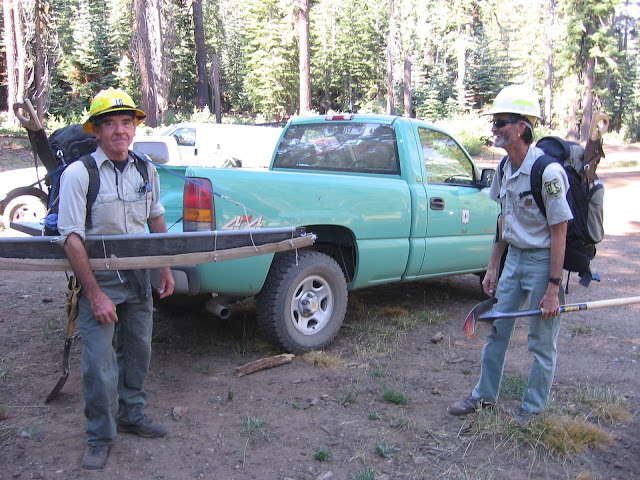 I met John Glenn (left) two and a half years ago when David and I were undergoing training to join the Madera County Search & Rescue team. John is an incredibly personable guy and we developed an instant rapport. He's an excellent teacher, and his knowledge of the wild is inexhaustible. John volunteers with trail crews all over the country, and has done just about everything from climbing and cutting trees to blasting granite with dynamite.
I met John Glenn (left) two and a half years ago when David and I were undergoing training to join the Madera County Search & Rescue team. John is an incredibly personable guy and we developed an instant rapport. He's an excellent teacher, and his knowledge of the wild is inexhaustible. John volunteers with trail crews all over the country, and has done just about everything from climbing and cutting trees to blasting granite with dynamite.Michael Olwyler (right) is the Wilderness Manager for the Ansel Adams Wilderness. He has a genuine passion for the wild and works hard to keep it clean and safe for visitors. He's also an avid photographer, often seen with his CANON 20D around his neck.
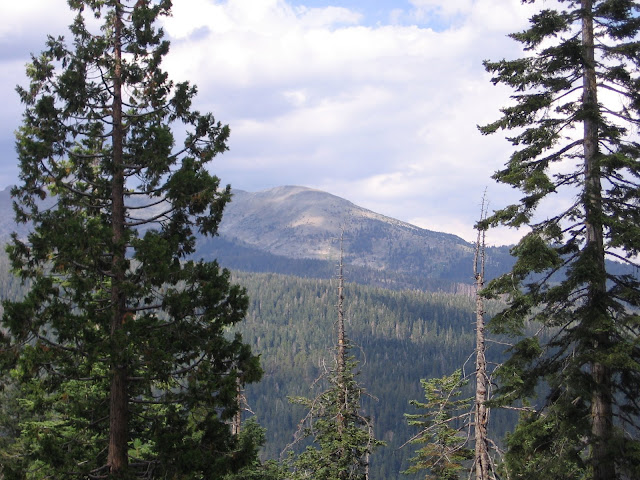 Thunderstorms were forecasted for the week, and I was looking forward to getting into some weather. (For all my time in the backcountry, I've never experienced a proper storm.) To my keen disappointment, the storms never materialized - not even so much as a distant rumble. Maybe next time.
Thunderstorms were forecasted for the week, and I was looking forward to getting into some weather. (For all my time in the backcountry, I've never experienced a proper storm.) To my keen disappointment, the storms never materialized - not even so much as a distant rumble. Maybe next time.Within the first 20 minutes, we came to our first log. We unslung our packs, assembled the saw, and commenced the ancient battle between tree and trail. This drill would be repeated several dozen times over the next few days, as we worked the 7 miles between the trailhead and the Inyo border.
As we hiked, John and Michael pointed out landmarks and filled me in on some of the history associated with different sections of the trail. We passed "Winston's Corner" - a shady, S-shaped switchback on the west slope of the gorge - where a stubborn mule named Winston had caused an infamous mule wreck years ago. It was a treat to learn some of the legends, lore, and legacy of the wilderness from men who have walked these trails for decades.
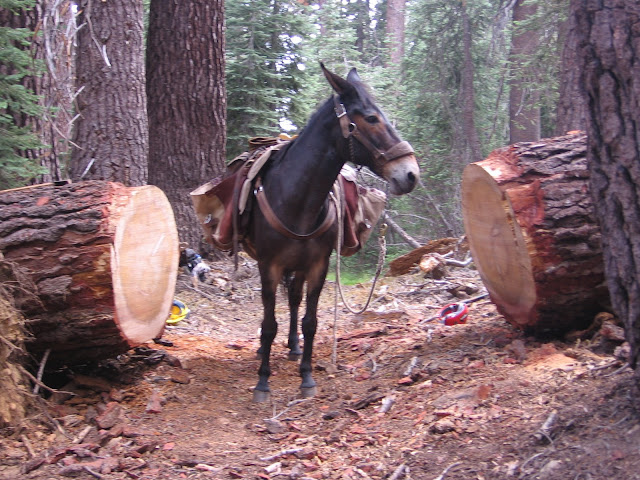 This is Mikey, trying out the trail through a freshly cleared tree. On a trip like this, it's really nice to have a packer bring most of the gear in on mules. John Baker managed this end of the expedition for us, with the help of another lady. They rode in on horseback, leading two pack mules each. John G., Michael, and I just carried day packs and our tools; all of our camping gear was on the mules.
This is Mikey, trying out the trail through a freshly cleared tree. On a trip like this, it's really nice to have a packer bring most of the gear in on mules. John Baker managed this end of the expedition for us, with the help of another lady. They rode in on horseback, leading two pack mules each. John G., Michael, and I just carried day packs and our tools; all of our camping gear was on the mules.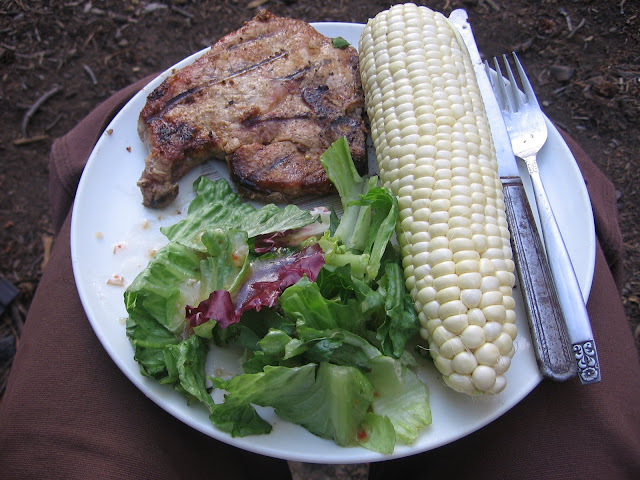 Bringing in mules allowed us to set up a bonafide camp at 77 Corral, and also to eat rather well. Dinner Tuesday night was grilled pork chops, corn on the cob, and salad. Definitely beats a cup-a-soup.
Bringing in mules allowed us to set up a bonafide camp at 77 Corral, and also to eat rather well. Dinner Tuesday night was grilled pork chops, corn on the cob, and salad. Definitely beats a cup-a-soup. The largest log we tackled was a 43" Red Fir several miles beyond camp. (Most of the logs were smaller - 18 to 24 inches, with a few 30-inchers.) After getting the cut started, it's important to drive plastic wedges into the kerf as soon as possible to prevent the weight of the tree from binding the saw. As the cut progresses, more wedges are added, and the previous wedges are driven deeper. John expertly analyzed each log to determine where it was likely to bind, where we should roll it, and how we should angle our cuts. There's a lot more to it than just pushing a saw back and forth.
The largest log we tackled was a 43" Red Fir several miles beyond camp. (Most of the logs were smaller - 18 to 24 inches, with a few 30-inchers.) After getting the cut started, it's important to drive plastic wedges into the kerf as soon as possible to prevent the weight of the tree from binding the saw. As the cut progresses, more wedges are added, and the previous wedges are driven deeper. John expertly analyzed each log to determine where it was likely to bind, where we should roll it, and how we should angle our cuts. There's a lot more to it than just pushing a saw back and forth.Not all logs required cutting. Depending on the size of the log and the lay of the surrounding terrain, some can simply be rolled out of the way. Using a combination of log levers, log pivots, log ramps, and brute strength, we successfully rolled trees that looked impossible. It's pretty exhilarating to get everyone pushing and see an enormous log go crashing off the trail.
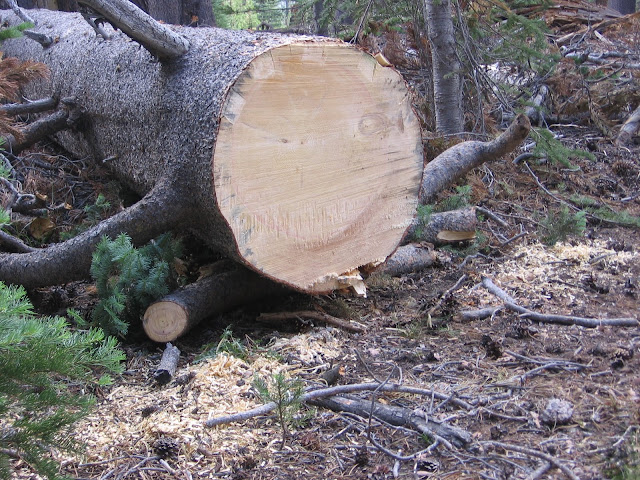 John's bucking saw - "Zina" - was a pleasure to use. This tool was the kingpin of the whole expedition. Cutting green wood on Thursday morning, the saw was throwing 5" chips out its greedy gullets, spraying them at my safety glasses. John carried it all day slung across his shoulder, and treated it with something akin to reverence. By the third day, it was easy to understand why.
John's bucking saw - "Zina" - was a pleasure to use. This tool was the kingpin of the whole expedition. Cutting green wood on Thursday morning, the saw was throwing 5" chips out its greedy gullets, spraying them at my safety glasses. John carried it all day slung across his shoulder, and treated it with something akin to reverence. By the third day, it was easy to understand why.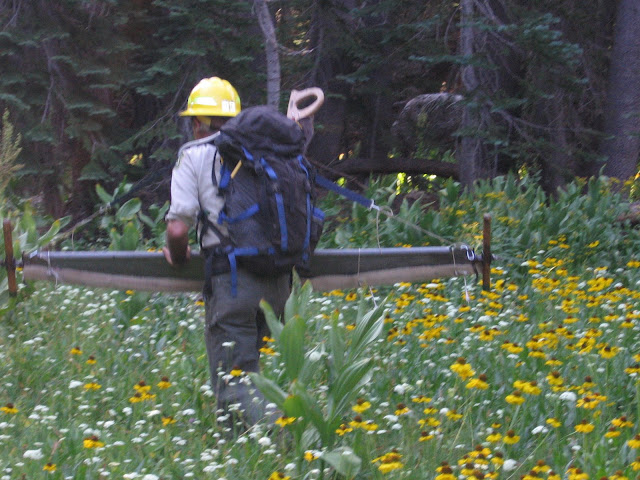 I'm used to hiking, and I'm used to working, but it was a whole new experience for me to combine the two. I heartily enjoyed both the physical challenge of doing the work and the mental challenge of understanding the techniques and working efficiently as a team. Perhaps the most rewarding thing was the sense of ownership that comes with trading your hiking poles for a shovel and ax. As a caretaker with invested sweat equity, one feels connected to the wilderness in a completely new way.
I'm used to hiking, and I'm used to working, but it was a whole new experience for me to combine the two. I heartily enjoyed both the physical challenge of doing the work and the mental challenge of understanding the techniques and working efficiently as a team. Perhaps the most rewarding thing was the sense of ownership that comes with trading your hiking poles for a shovel and ax. As a caretaker with invested sweat equity, one feels connected to the wilderness in a completely new way.












No comments:
Post a Comment